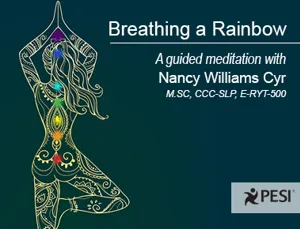Breathing the Rainbow: A guided meditation

The field of integrative treatment has rapidly expanded, and when speaking of this topic we focus not only on the physical/structural anatomy but also an invisible structure known as the energy body.
The energetic body has seven primary energy centers, called chakras, housed along the spine from the tip of the tail bone to the top of the head.
The seven chakras include:
When you start to feel anxious or irritated, taking a few minutes to realign your chakras can help calm the body. Here's a guided meditation you can practice:
This blog is based on the seminar Yoga for Self Regulation presented by PESI speaker Nancy Williams Cyr, M.SC, CCC-SLP, E-RYT-500.
The energetic body has seven primary energy centers, called chakras, housed along the spine from the tip of the tail bone to the top of the head.
The seven chakras include:
- Root Chakra – Stability
Represented by the color red, it is located at the bottom of the tailbone. Here we learn about establishing our foundation and the security of our family unit. - Navel Chakra – Relationship and Creativity
Represented by the color orange, this chakra is located in the abdomen. This is where we become more aware of lessons about relating to others. It’s here where we begin the process of individuating from the family. - Solar Plexus Chakra – Self-Esteem
Represented by the color yellow, this energy center is located above our waist and below our heart. It’s here where the student’s identity is cultivated and energy is exchanged between the student and the environment. - Heart Chakra – Love and Compassion
Represented by the color green, the heart chakra is located in the center of the chest close to the physical heart. It’s here where we learn lessons of love and compassion and how to heal past wounds. - Throat Chakra – Communication
Represented by the color blue, the fifth chakra is located in the throat. When stimulated with yoga, lessons of self-expression arise. When this chakra is balanced, we are better able to reach our goal of being clear in our communications. - Brow Chakra – Divine Vision
Represented by the color purple, it is located in the brow area and is often referred to as the third eye. It is here where imagination and intuition are stimulated and self-reflection is evoked. - Crown Chakra – Spiritual Connection
Represented by lavender, the chakra is located at the top of the skull. This energetic spot pertains to grace, soul and the Universe. It is here that we feel the energy of self-unification, or a coming together of our personality with our highest self.
When you start to feel anxious or irritated, taking a few minutes to realign your chakras can help calm the body. Here's a guided meditation you can practice:
This blog is based on the seminar Yoga for Self Regulation presented by PESI speaker Nancy Williams Cyr, M.SC, CCC-SLP, E-RYT-500.





